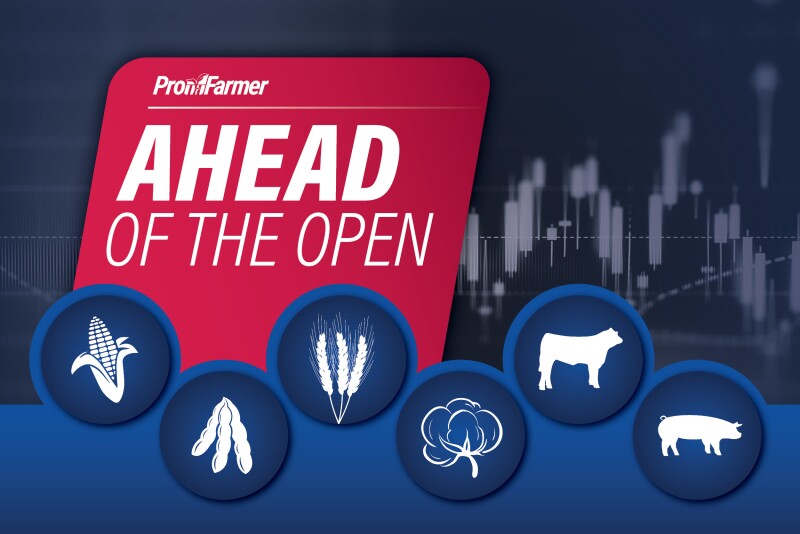GRAIN CALLS
Corn: 1 to 3 cents higher.
Soybeans: 7 to 10 cents higher.
Wheat: 1 cent lower to 1 cent higher.
GENERAL COMMENTS: Soybeans led strength overnight and pushed to a fresh 17-month high, breaking above the recent sideways range. Corn and wheat continue to consolidate, garnering little bullish momentum from beans. USDA has begun to release their backlog of data, releasing the first export sales report in seven weeks this morning, though the data was from September. Outside markets are relatively quiet this morning as front-month crude oil futures are modestly higher while the U.S. dollar index is around 200 points lower.
President Trump overnight signed legislation to end the longest U.S. government shutdown in history, marking the conclusion of the 43-day closure. Trump’s signature means the government can begin to resume normal operations, with federal workers expected back on the job starting today. However, it could still take days or even weeks for federal workers to fully restart their operations and dig out of the backlog after being off their jobs since Oct. 1. U.S. Transportation Secretary Sean Duffy told reporters Wednesday he anticipated it could take as long as a week to start lifting flight restrictions at major airports. USDA food aid won’t immediately snap back as states say they need as long as a week to update their beneficiary files and load debit cards, reported Bloomberg. The shutdown fight has weighed on the U.S. economy, with the Congressional Budget Office projecting a six-week government closure would lower real gross domestic product growth in the current quarter by 1.5 percentage points. The interim spending package funds most of the government through Jan 30, raising the prospect of another shutdown fight at that time.
Global crude oil markets are oversupplied, and it’s most obvious in the Americas, especially the U.S., Bloomberg reports. The futures curve for U.S. benchmark West Texas Intermediate is in a contango structure — in which later-dated contracts trade at a premium to nearer ones — for most of 2026, suggesting weaker demand for prompt barrels. Further signs of healthy supply in the U.S. can be seen in high export volumes. U.S. crude exports for October came in at the highest since July 2024, according to government data. The equivalent curve for global crude oil marker Brent, meanwhile, is largely flat in the months after March. The difference between the two reflects the varying degrees of oversupply that regional crude markets are experiencing. The flat curve suggests demand for prompt Brent barrels is also lackluster. Globally, oil market watchers are broadly expecting a glut next year. OPEC, which has long held the view that oil demand would remain healthy, flipped estimates in the third quarter from a deficit to a surplus on higher U.S. production.
USDA released their weekly export sales report this morning, though the data was for the week ended Sept. 25. Corn sales totaled 1.395 MMT, down 27% from the previous week but well above average. Soybean sales totaled 870,500 MT, up 20% from the previous week but well below average. Wheat sales totaled 315,900 MT, down 41% from the previous week and below average.
CORN: December corn are trading in the upper end of the recent sideways range. Resistance stands at $4.37 on a push higher, while support stands at $4.32 1/4.
SOYBEANS: January soybeans rallied to fresh highs overnight. January beans hit a 17-month high and are extending higher, with additional resistance at $11.45 then $11.50. Support stands at $11.35 then $11.21 on profit-taking.
WHEAT: December SRW continue to trade in a tight range. The upside has largely been limited by 100-day moving average resistance at $5.35 1/2 while support persists at $5.29 1/4. A close outside of those levels likely determines the near-term direction.
LIVESTOCK CALLS
CATTLE: Choppy/lower.
HOGS: Choppy/lower.
CATTLE: Cattle futures are expected to open with a mostly weaker tone in a continuation of recent selling pressure. Prices continue to trend lower on the daily bar chart with bears cementing the technical advantage with the downturn the last couple days. Cash cattle trade has began at modestly lower prices from last week but trade remains light so far this week. Wholesale beef saw losses Wednesday with choice cutout falling $4.77 to $374.45 while select sunk 14 cents to $359.94.
HOGS: Lean hog futures are expected to open with a mostly weaker tone in a continuation of yesterday’s selling pressure. Prices continue to trade in Tuesday’s wide range. Bulls struggled to maintain recent bullish momentum as cash fundamentals continue to fade seasonally. The CME lean hog index is down another 4 cents to $89.13 as of Nov. 11. Pork cutout slid $1.24 to $96.14 Wednesday as losses in ribs led cutout lower.

